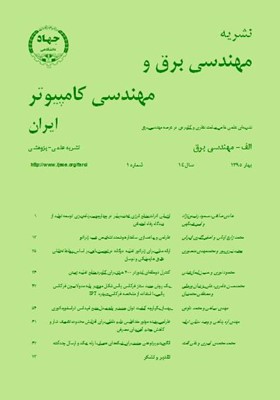بهساز يکپارچه کيفيت توان جدید بر پايه مبدل منبع امپدانس ترانسفورماتوري
محورهای موضوعی : مهندسی برق و کامپیوتر
1 - مکانیک ، برق و کامپیوتر
2 - دانشگاه آزاد اسلامی، واحد بینالمللی کیش
کلید واژه: بهساز يکپارچه کيفيت توان (UPQC) اينورترهاي پشت به پشت مبدل منبع امپدانس ترانسفورماتوري,
چکیده مقاله :
بهساز يکپارچه کيفيت توان (UPQC) متشکل از اينورترهاي منبع ولتاژ پشت به پشت، تلفيق فيلترهاي اکتيو سري و موازي است که به صورت همزمان هارمونيکهاي جريان بار غير خطي و اغتشاشات ولتاژ شبکه را جبران ميکند. براي کارکرد مناسب هر دو مبدل و عبور دوطرفه توان، بايد ولتاژ لينک DC حداقل 41/1 برابر ولتاژ خط به خط سمت ولتاژ بالاي سيستم يعني فيلتر اکتيو موازي باشد. يکي از فاکتورهاي تعيينکننده قيمت ادوات نيمههادي، حداکثر استرس ولتاژ قابل تحمل آنها ميباشد. با بالابودن ولتاژ لينک DC، استرس ولتاژ کليدهاي سمت مبدل سری افزايش مييابد و براي رفع اين نقص، در اين مقاله يک شبکه منبع امپدانس به ساختار اينورترهاي پشت به پشت رايج در UPQC اضافه میشود که بدين وسيله ولتاژ DC اعمالي به اينورتر فيلتر اکتيو سري را به ميزان چشمگيري کاهش داده و هزينه ساخت آن کاهش خواهد يافت. در اين ساختار از شبکه منبع امپدانس در يک مبدل AC/DC (فيلتر موازي) براي ايجاد خاصيت باک- بوست استفاده شده است. در عين حال به علت استفاده شبکه منبع امپدانس در فيلتر موازي، زمان مرده لازم براي کليدزني اين مبدل حذف شده و کيفيت عملکرد و قابلیت اطمینان آن به ميزان چشمگيري افزايش خواهد يافت. در این مقاله با شبيهسازيهاي لازم کارايي ساختار رايج و پيشنهادي با هم مقايسه خواهد شد. برای اثبات کاهش هزينه ساخت در ساختار پيشنهادي از معيار Total Switching Device Power استفاده شده است.
Unified Power quality conditioner (UPQC) consists of back to back voltage source inverters. In UPQC combination of parallel and series active power filters are used to compensate for the nonlinear load current harmonics and voltage distortions, simultaneously. For appropriate performance of both converters and bidirectional power flow, the DC link voltage should be at least 1.41 times larger than the line to line voltage in the high voltage part of the system; i.e. the parallel active filter. One of the determining factors for the cost of semiconductors is the maximum tolerable voltage stress. The voltage stress of the series converter increases when the DC link voltage is high. In order to overcome this deficiency, a Z-source network is added to the common structure of back to back invertors in the UPQC. It will reduce the applied DC voltage to the series active power filters significantly and decrease the cost of manufacturing. In this structure, an impedance source network is used in an AC/DC inverter to produce a buck-boost effect. Additionally, dead time has been eliminated through the use of a Z source network in the parallel active filter and thus its performance and reliability has increased impressively. In this paper, a comparison study has been conducted through necessary simulations for the performance evaluation of the common and proposed structures. The total switching device power has been used as a criteria to confirm the manufacturing cost reduction in the proposed structure.

